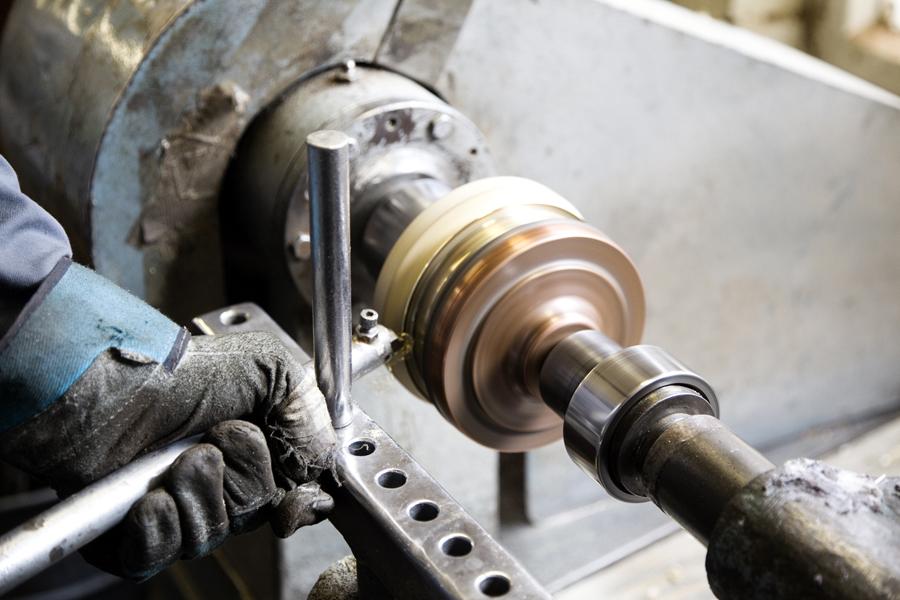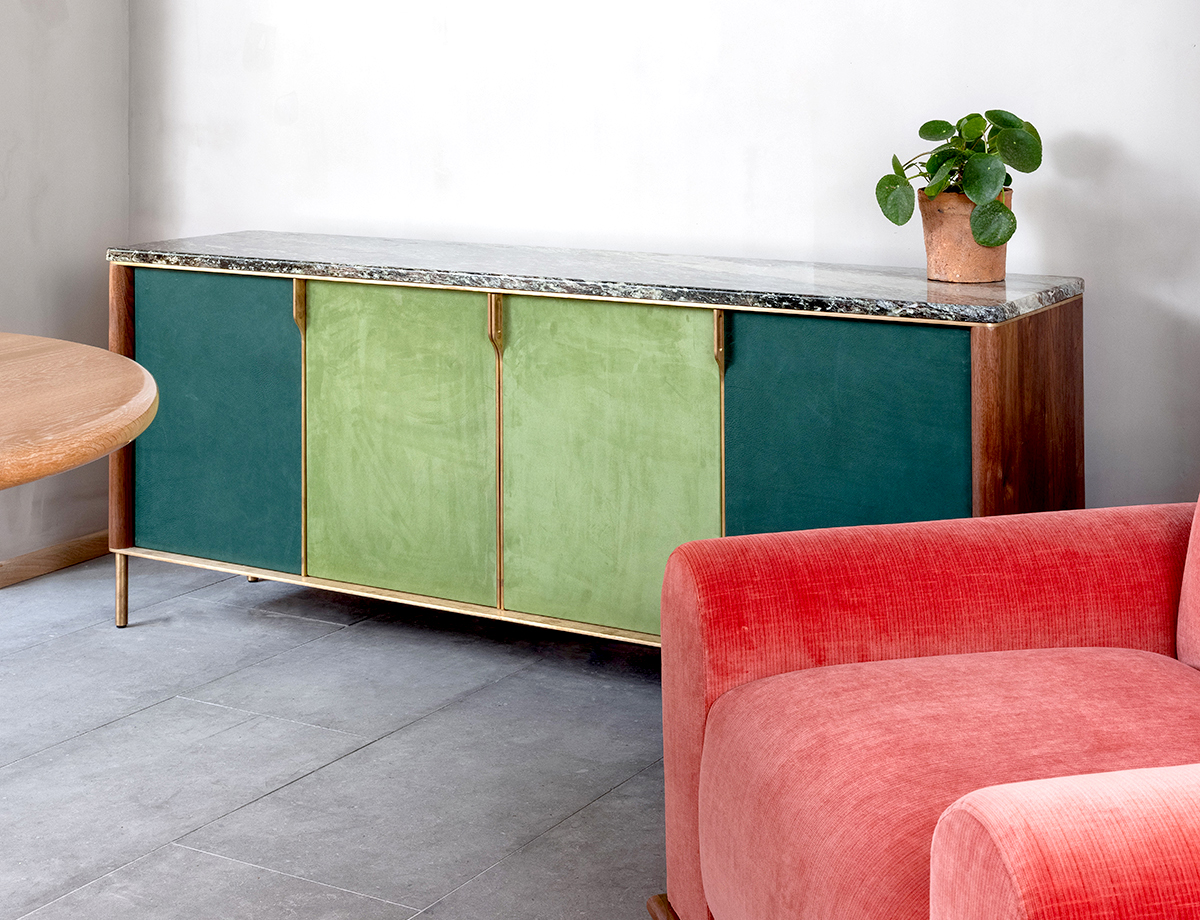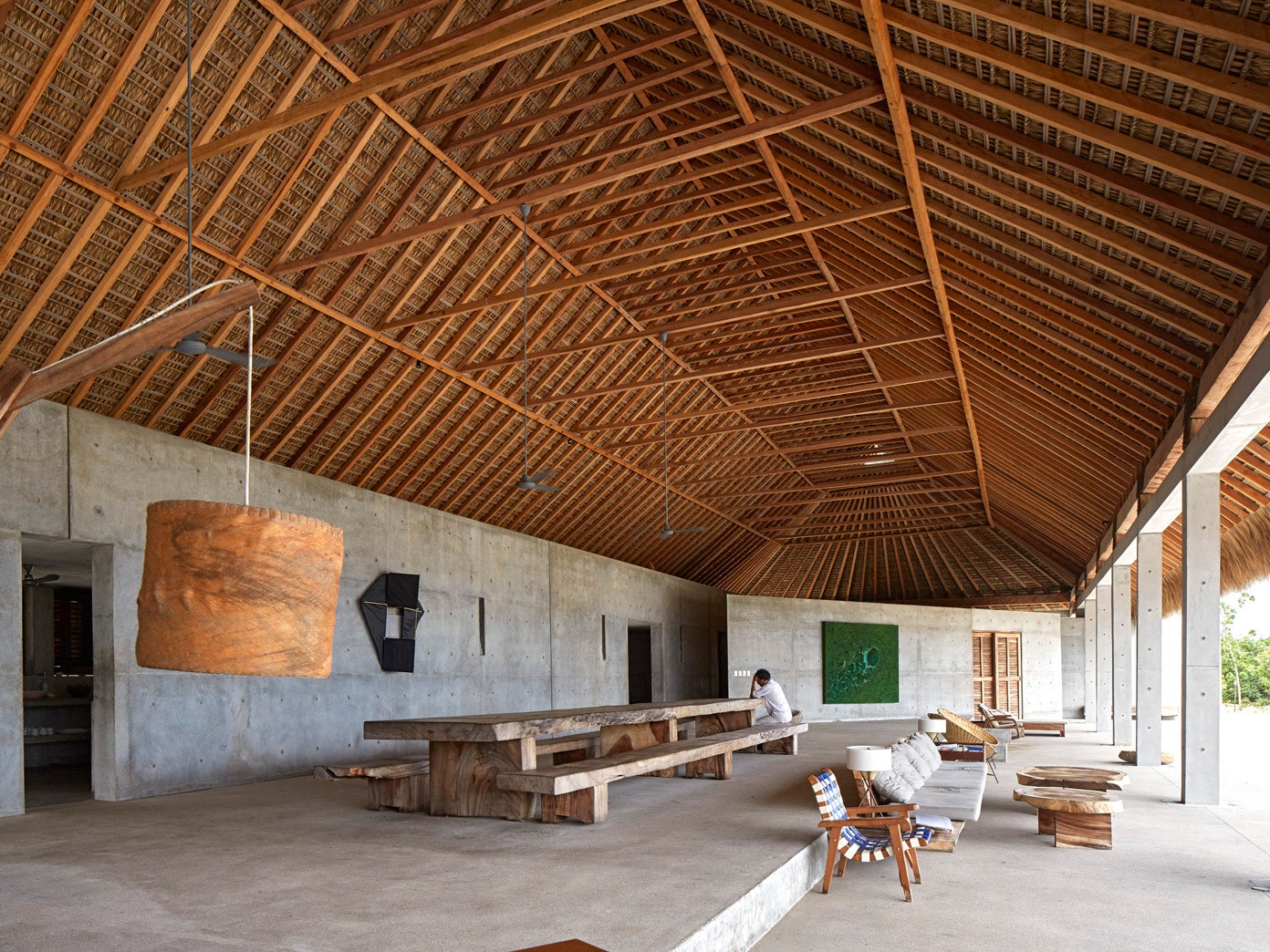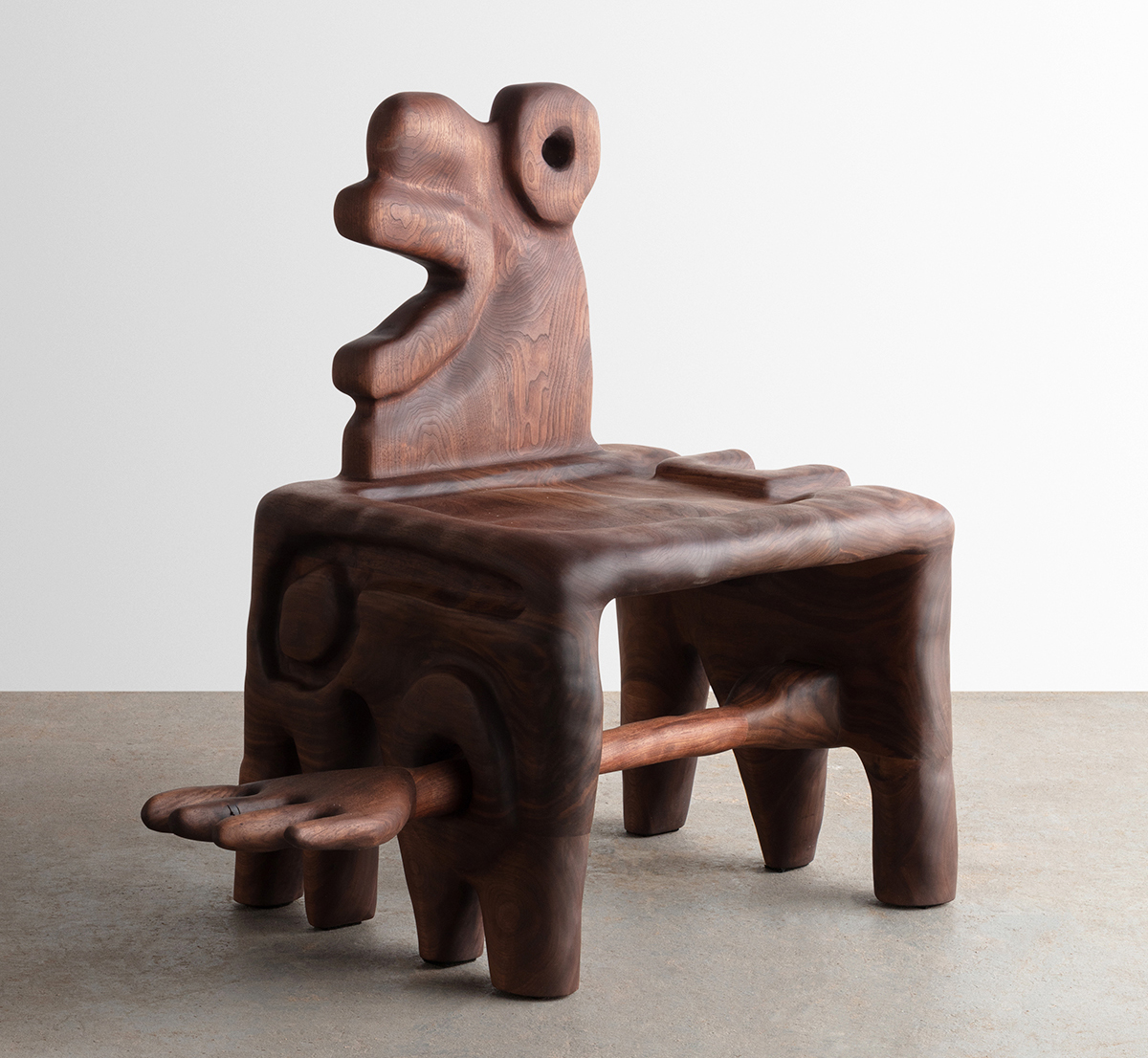
06.06.22
Q+A
Casey McCafferty’s Mythological Furniture Keeps Getting Bigger
Whether it’s Aztec carvings, Native American totems, Norse idols or African masks that you see in Casey McCafferty’s work, the Los Angeles and New Jersey–based designer uses mythology from all of these diverse cultures to inform his fantastical furniture creations. Heavily influenced by Joseph Campbell and Bill Moyers’ The Power of Myth conversations, as well as historical science fiction, he blends characters from archeology and lore with shapes found in nature when carving pieces from wood and stone that each have their own personality.
Self-taught, McCafferty has no art school or technical training; in fact, he initially studied business and worked for a bank. But after stumbling upon a wood shop in college, he started to play around at nights, initially working in more traditional fabrication, then shifting to more sculptural explorations around 2016. These began as primitive forms, but have gradually become more adventurous as he experiments with the shapes of supports, appendages, and apertures — all in a lumpy and rounded manner as if weathered over time. “I guess I’m trying to push to see how far I can get away from conventional furniture, and still have people buy it,” he says.
Each of his designs follows on from the last, a personal “exquisite corpse” exercise in which one or more elements he likes from a previous piece are incorporated and developed in the next. As a result, McCafferty’s work keeps growing in size and ambition — he’s just finished a seven-foot-tall throne and has plans for more. His studio in New Jersey is filled with a menagerie of tools for hand shaping the increasingly large (and heavy) wood and stone sculptures. There’s no computer modeling involved, and he finds drawing limiting too. Instead, he starts with a block of material roughly the dimensions he wants, and starts hacking away until he’s happy with the result.
Ahead of a solo show at Nino Meir Gallery, which opened this weekend in LA, McCafferty spoke to us about his teenage years building subwoofer enclosures for friends’ cars, the side table that changed his career trajectory, and the similarities between the sculptures of different ancient civilizations.
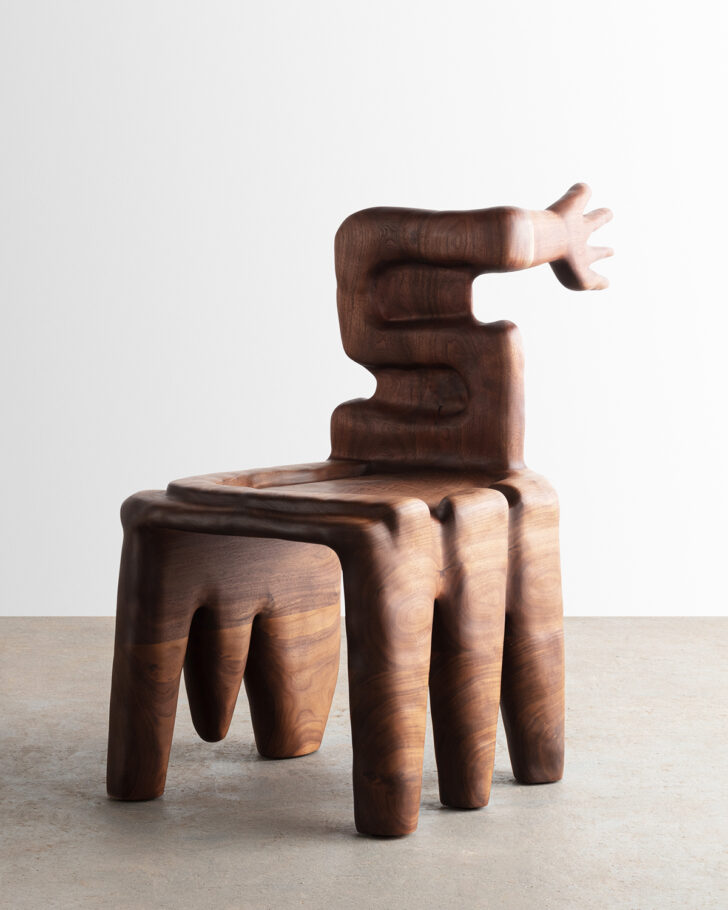
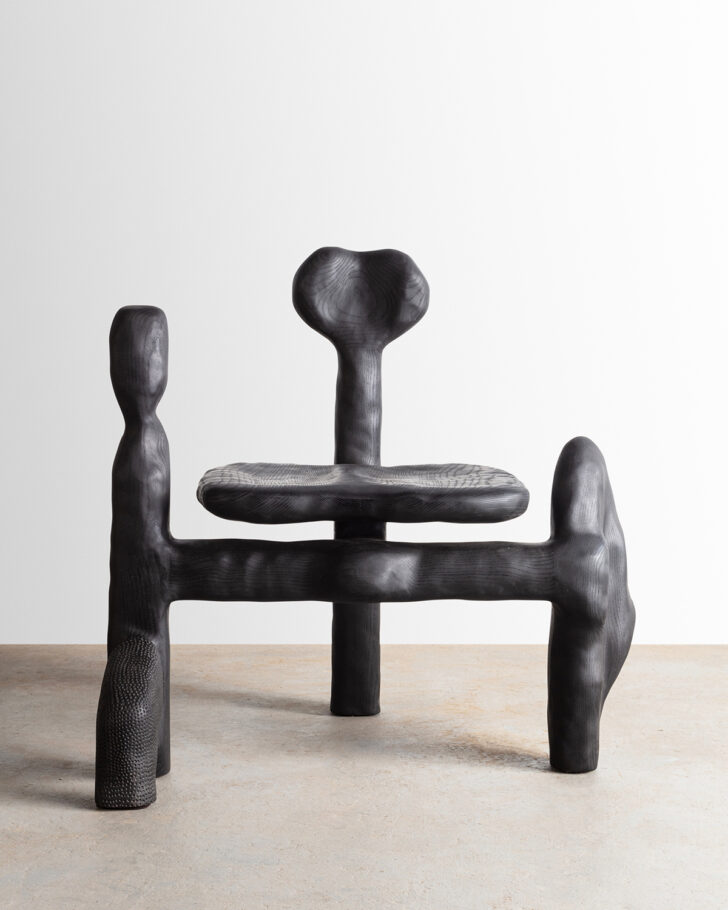
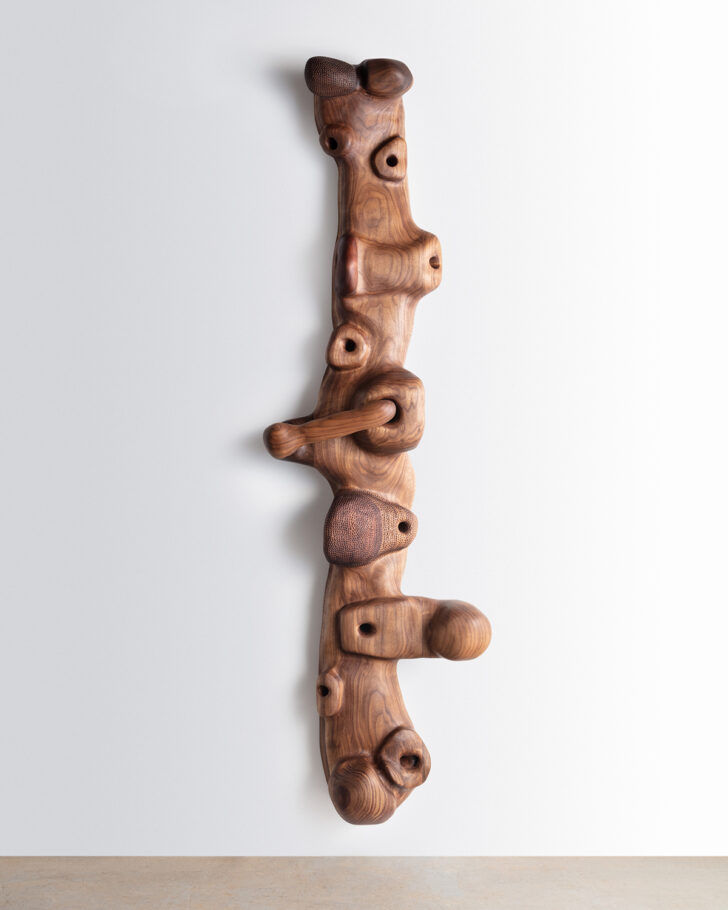
How did you first get into design?
I spent my entire childhood doing different tasks around the house. My dad never wanted to hire anybody to do anything. He was a firefighter, but on his time off, we were building furniture for outside or working on the car. So, I feel like my hands got very used to problem solving and creating from an early age. And then I dabbled with a lot of weird things as a child. Those subwoofer enclosures that people used to put in the back of their cars, made out of fiberglass — I would use epoxy to improvise and create weird organic structures that would fit the subwoofers for all of my friends.
Then I got into building computers and a lot of different things. When I was in college, where I got access to a wood shop, and I forget what piqued my interest exactly, but I saw a chair being built somewhere, maybe when watching TV, and thought “this looks really relaxing.” So I started getting my hands dirty in the workshop. Whatever I get into, I really dive into it. And then a couple of months later, I either find the next hot thing to dive into, or I lose interest and something else comes up. But woodworking was one of those things that I just wanted to keep learning more and more and more.
I was working for a bank after college, and working in the workshop at night and working on furniture. It got to a point where I had a couple of projects that I could, you know, pay rent with, so I just made the jump and I quit banking. I got my workshop and moved to Los Angeles, and was really lucky that I got connected with some design showrooms that wanted me to build their custom furniture, which I did for a long time.
The way I got into sculptural furniture was that I was getting burnt out with building to spec for interior designers. Then one day an interior designer walked into my studio and she saw one of my little weird side tables sitting on a pallet, and asked me if it was available, because she had a client looking for a unique side table. And I said, of course it was! And she went ahead and bought it. Then something clicked in my brain that people are more interested in buying something that is authentic and unique to you, than if you’re just building to specification based on drawings. There’s nothing wrong with being a fabricator, but it’s not the same as being inventive with your world. So I would say a year from that point, I completely switched my practice to being solely about functional sculpture, with a little regular sculpture too.
So you didn’t go to school for design?
No, I have no background or training. No art school. No technical school for woodworking. Everything is self taught, and figured out while I’m doing it. Instead I studied International Business. I didn’t really have any interest in going to college. It was something my parents were like, “No, this is what you do. You go to college.”
I thought, okay, my brother is going to this college, so I’ll go there too so I can live with him and have fun. And I’ll do the business thing. After graduating, I got a good internship at Citigroup but it was soulless to me. I know some people enjoy it but for me, commuting into Manhattan every day, sitting there doing something that I wasn’t really into. It fills your life with so much stuff that you don’t want to do, and you’re always looking forward to the weekend when you don’t have to go work. It just wasn’t wasn’t for me.
When exactly did you switch from traditional fabrication over to more sculptural furniture?
Around 2016 or 2017 was when I moved completely over. I got to a point where I had another person fabricating normal furniture for me, while I was doing the sculptural stuff, but then I phased that out, too. But for as long as I’ve been working with wood, I’ve been building those types of pieces — just not for customers, but for any friends and for myself. And it was just that realization when I switched the whole business model over.
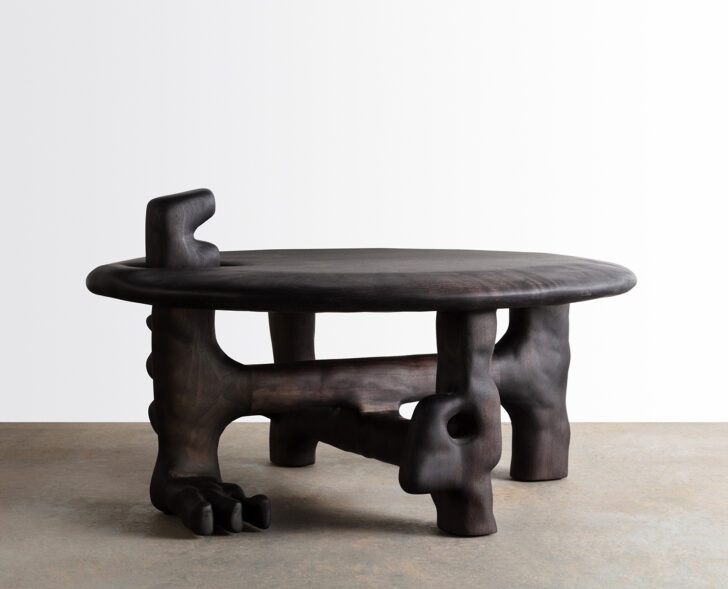
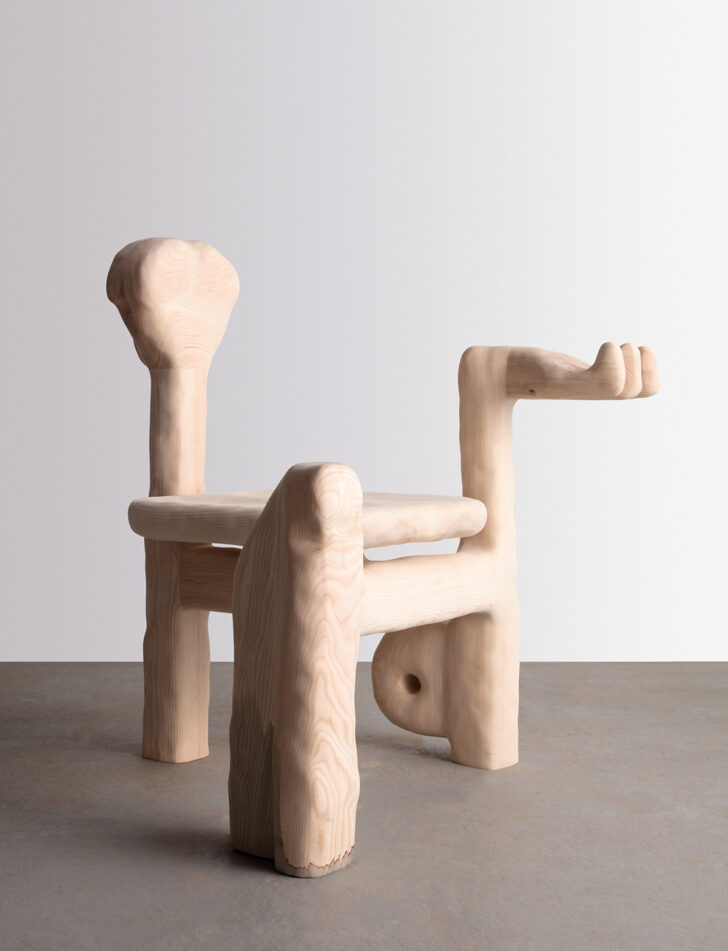
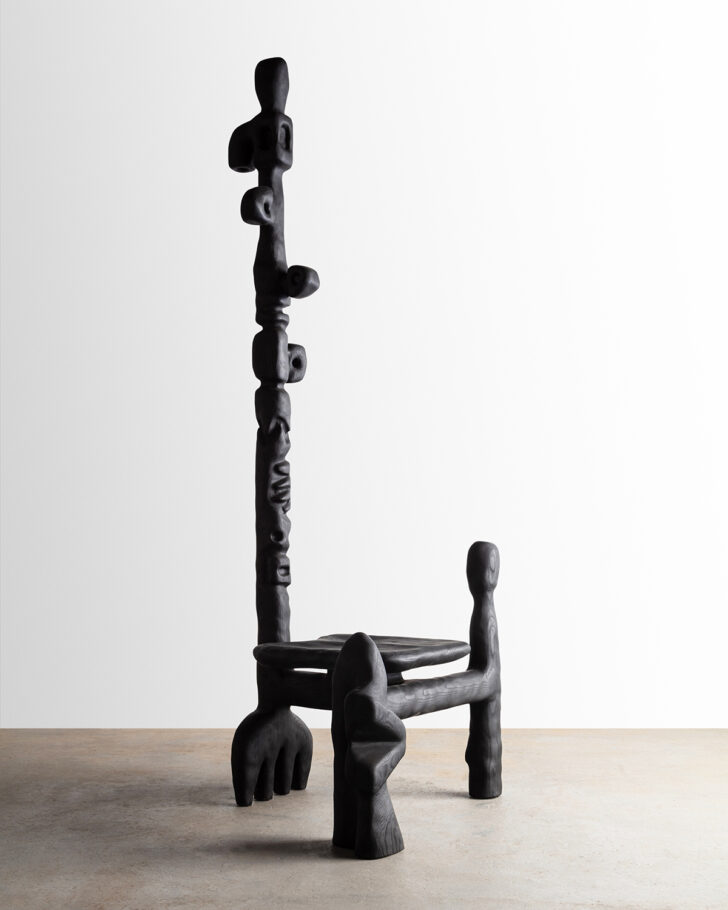
Over the past six years, how has your style evolved from those early sculptural pieces to what you’re making today?
I would say it’s more adventurous. After I dipped my toes into it, every piece that I made — if I had a client willing — I tried to push a little bit further. My first pieces were abstract; they were different but they were still pretty simple and probably primitive looking. Now any time I have a new piece, there’s maybe a little bit more detail on it. I’ve been trying not to just stay safe with abstract work, but adding in more figurative pieces. I guess I’m trying to push to see how far I can get away from conventional furniture, and still have people buy it.
The way that I generally come up with the next idea is I’ll be working on a coffee table that has six legs… I don’t do that many drawings, and I’m not trying to figure out what I’m carving before I start. So the client will give me specific dimensions, because that’s just what fits in their house, and then they’ll give me free rein. Sometimes, five out of the six legs are okay and like I like them, but they’re not really pulling in. But then one leg really clicks. So the next piece I build will be based on that leg because I just fell in love with the shape. I need one piece to get to the next piece, to get to the next piece, to get to the next piece…
In terms of visual themes, where do you draw your inspiration from?
I’m really into mythology from all cultures: Norse, Greek, African — the history behind the people who follow these mythologies, and also the mythologies themselves. There is a book with a conversation between Bill Moyers and Joseph Campbell called The Power of Myth, which was a really good read and made me understand why I’m so interested in all this stuff. It explains the philosophy of how all of these different mythologies are connected. And then I’m also into science-fiction reading, but mixed with history. So I think it’s a mixture of all that.
I think there’s a love of the outdoors that comes through my work, just seeing shapes of rocks, as simple as that. If I look at my work, there’s the faces and the hands. It’s just all natural. And I feel like that’s what connects most of the cultures around the world. If you look at ancient Norse sculpture, ancient Egyptian sculpture, they all are very similar. They might have different decorations and stuff, but the carvings are very similar. That’s just the way humans depict being human when carving something without the skill to make it anatomically correct. We all naturally drift to making the same types of shapes. So I feel like my work is kind of a modern example of that. There’s no particular tribe or specific culture that has precedence over another. It’s kind of just whatever’s floating around out there.
Can you give some specific examples of recent pieces you’ve completed?
I just finished a big sculptural coffee table that is kind of an evolution of my functional sculpture. I never liked how, if I was asked to make a table, I could make the legs look really cool. But then the top needs to be functional and flat. So you lose the whole underbody because of the top. So in my new work, I’m trying to convince people slowly to let me make the top in the same style too. It might not function as well, you might not be able to slide a glass down the table, but it will make it way more interesting.
A lot of my more recent work has dealt with the flowing of the legs or the parts at the bottom all the way to the top. I’m trying to make the piece look more like one whole unit, rather than a really cool base with just the top put on it. Typically, everything that I do is usually permanently attached. If I’m using stone, I’ll permanently attach it to the wood. But I’ve been experimenting with pieces that come apart and fit together, and for this coffee table, I carved a stone that has an abstract shape on it, and I just let it sit into a hole I carved into the table. You could take it out, you could put it in. It adds to the interactions that the client can have with a piece.
I just made another piece that’s super interesting. I’ve made a lot of chairs in my time, which are 42 inches high, with a seat height of 18 inches, and that have normal widths and depth because they have to fit under a dining table. But I just made a big throne. I’m really starting to really get into thrones, and this new one is seven feet tall by 36 inches wide. It’s a really good combination of my sculptural totem work and function. It’s got hands and arms sticking out, yet it’s still comfortable, which is cool.
Again, it’s thinking about how far I can push it with the sculpture, and still have some function in the piece. I have a gut feeling that I want to start doing bigger things. I’ve started moving away from making side tables and smaller pieces, and I’m trying to get a little bit more grand with my sculptures. My totems were originally more traditional and straight up and down. But now I’m trying to make them more weighty and bring more movement in them. So I think the shapes are evolving, and the sizes are evolving, and the pieces are getting heavier. That’s the direction I’m going in.
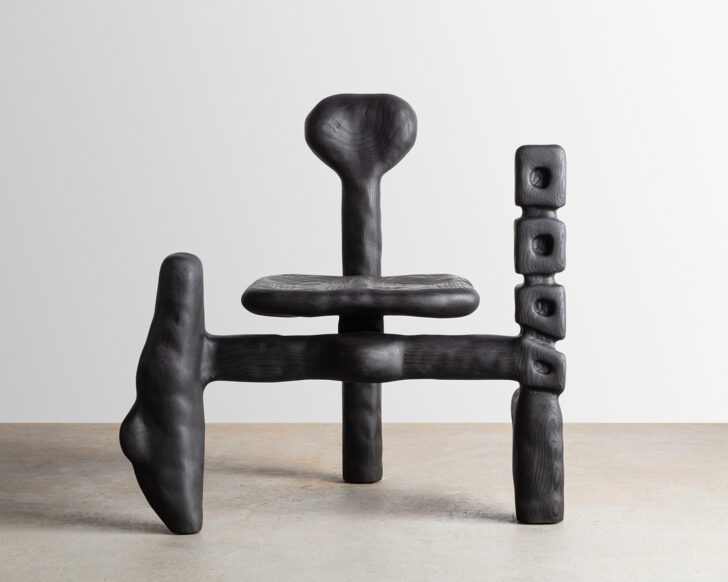
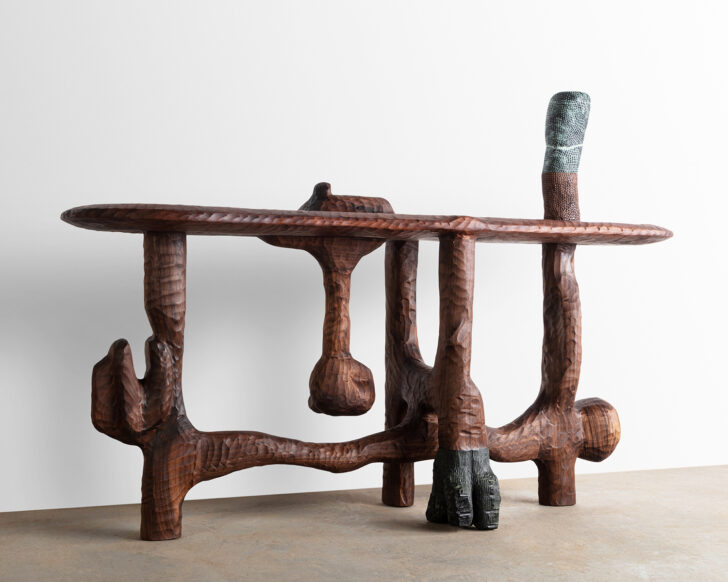
You said you go from one piece to the next in terms of ideas. But how do you go from an idea to then producing and fabricating the product?
So I don’t draw. I can draw basic stuff, but I don’t have the skill to draw what I really want to produce. It’s an insecurity of mine to give a client a drawing of a piece that I want to do and I’m like, “This is it but it’s gonna be much better, don’t worry.” There’s no selling point with that.
If I’m just building a piece that I want to build, I’ll start with the idea in my head: okay, I want to build this armchair, I want it to be seven feet tall, and I want to be these dimensions. So I have a basic form that I glue up with wood. And then a lot of it will be just randomly laminating and gluing on blocks of wood. And at the end of the gluing process, I’ll have like this massive, glued up piece. Then I’ll start thinking back to how on the last table, I really liked this leg. So now with what I have in front of me, how can I translate that?
For some reason, if I plan too much before I start scoping, I’m just not interested in doing it. I gotta figure it out as I go along. With clients, if they’re commissioning a specific piece, I’ll send them a Dropbox link of a bunch of photos and ask them to pull the ones that they feel really connected to? And I’ll ask them which ones repelled them, because then I’ll move away from that style and more towards another. It doesn’t mean it’ll look anything like the examples but at least they know which kind of way it will go. At the end of the day, people are buying these pieces, and I want them to look at them and feel some joy.
Do you always use the same types of tools?
I don’t use any type of computerized tools. I know some people that are super talented artists and they get their kicks out of designing it on the computer, and then CNC-ing it out and bringing it to life. That’s just not my style.
But I do use power tools like grinders with a bunch of different blades. There’s so many. Every time I find a new one, I buy it to try it out. I have like 1,000 hand tools like mallets and gouges, and grinders with different blades that all do something different. I have chainsaws. And then I have the classic woodworking tools for milling and gluing up, because the process always starts with strong square joints and flat boards.
It’s always evolving, and there’s always times when I think, “Oh, if I get this, I can get into a deeper area here.” Or, “this could make this process a little bit easier,” or “I could try something new with this tool.” So I’m always looking and experimenting.
Is there a particular type of wood that you prefer to work with? Or does it depend on the project?
I usually decide with the client. If I’m using dimensional lumber, I’ll only use wood that is native to the US, because I don’t want to source tropical woods from other countries when we have enough trees being cut down here. Usually, it’s ash and walnut. I use ash because I can manipulate the color — I do black, white, sandblasted. For some adventurous clients I’ll do colors like blue, oxidized and stuff like that.
Walnut is the other big one because it’s just a beautiful wood and looks very nice oiled, and can be oxidized in dark blue. Then there’s white oak, but you can pretty much do anything with it that you can do with white ash. So I try to convince clients to use that.
But then if I’m carving straight from an actual tree, I have friends that have an urban tree salvage yard in Los Angeles. They go around the city and they salvage fallen trees, and then they dry them out to kill the bugs. I can buy my full logs from there and that’s all local woods, mostly ash and eucalyptus in California. I like doing that too, because I can support local people while helping out the world a little bit.
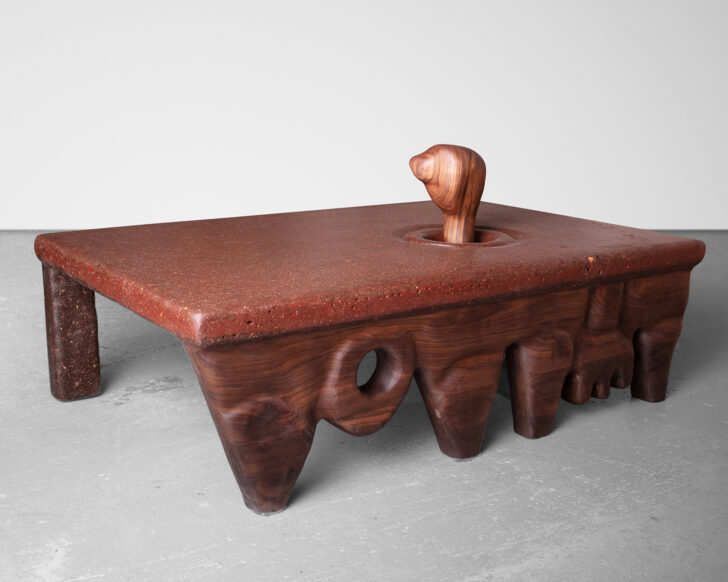
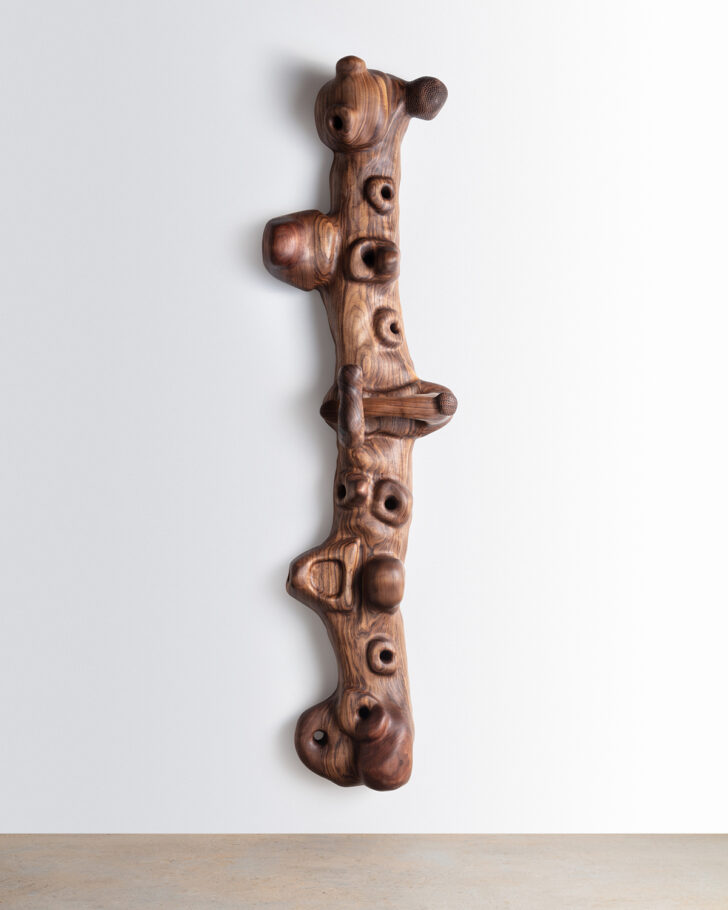
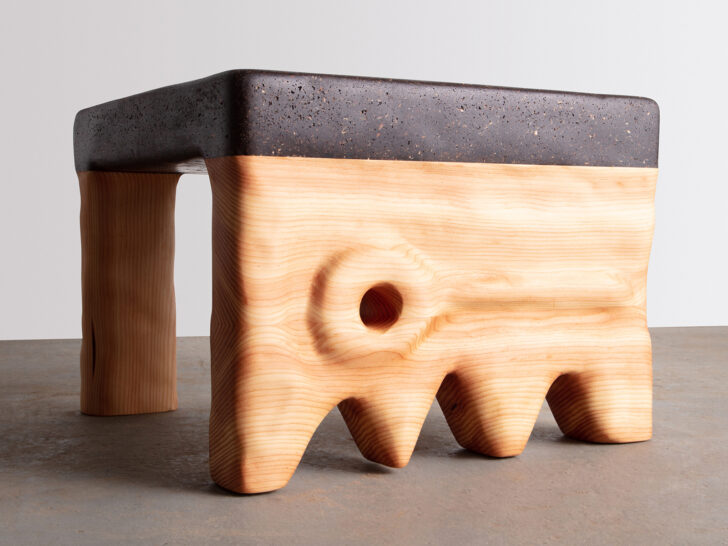
How did you begin to incorporate stone into your work?
I grew up working with masonry, coming from a line of bricklayers and stonemasons, so I’ve always had the skill to work with stone. A couple of years into doing sculptural work, I brought in my stone skills. I started carving stone and combining that with my wood, and ever since that has been a combo.
You mentioned you have a show coming up. Where else can people find your work?
Yes I have a show at Nino Meir, which is a contemporary art gallery in LA, which runs until July 9. I have work in a couple of different galleries, including Coup D’Etat, which is based in San Francisco and also opening up in Los Angeles. I’ll be having some special pieces come out in August with The Future Perfect in Los Angeles, which is cool. And then I work with a really cool, functional contemporary art gallery in London called Gallery Fumi, which is where you can see my pieces in person.
It’s been great to work with different galleries. I was on Sight Unseen’s American Design Hotlist in 2019, I think that got a lot of people’s attention. A lot of collectors came to me and a lot of galleries wanted to represent my work. Ever since then it’s been a lot of fun. It’s really awesome when you just get to build whatever you’re passionate about, and there’s a good chance that you can sell it. So I’ve been really fortunate and I’m grateful.
Also, if someone’s interested in a studio visit, I love having people come by if I’m available so they can see the whole process. That’s in New Jersey.
